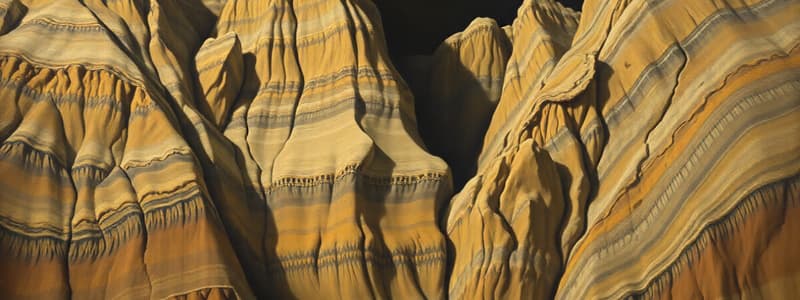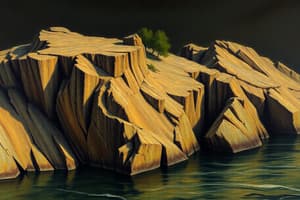Podcast
Questions and Answers
What characterizes a fold in geology?
What characterizes a fold in geology?
- A wave-like structure created by bending rocks (correct)
- A crack in the earth's crust
- A flat layer of sedimentary rock
- A type of volcanic formation
What is the opposite behavior of ductile in materials?
What is the opposite behavior of ductile in materials?
- Plastic
- Brittle (correct)
- Malleable
- Elastic
Which stress type is primarily responsible for causing folds in rocks?
Which stress type is primarily responsible for causing folds in rocks?
- Compressional stress (correct)
- Tensional stress
- Shear stress
- Rotational stress
What type of fold typically has the oldest rock beds at the core?
What type of fold typically has the oldest rock beds at the core?
What distinguishes linear folds from other fold types?
What distinguishes linear folds from other fold types?
The steepness of dipping rocks in an anticline decreases towards which feature?
The steepness of dipping rocks in an anticline decreases towards which feature?
Which of the following is NOT a type of linear fold?
Which of the following is NOT a type of linear fold?
Which condition is likely to promote ductile behavior in rocks?
Which condition is likely to promote ductile behavior in rocks?
What characterizes a thrust fault?
What characterizes a thrust fault?
Which statement accurately describes synclines?
Which statement accurately describes synclines?
What is the main difference between antiforms and anticlines?
What is the main difference between antiforms and anticlines?
What defines isoclinal folds?
What defines isoclinal folds?
In what way are recumbent folds different from overturned folds?
In what way are recumbent folds different from overturned folds?
How are plunging folds defined?
How are plunging folds defined?
What characterizes chevron folded rocks?
What characterizes chevron folded rocks?
Flashcards
Fold in Geology
Fold in Geology
A bend in rock layers, rather than a break, due to deformation.
Ductile Behavior
Ductile Behavior
The ability of a rock to deform without breaking under pressure.
Compressional Stress
Compressional Stress
Squeezing force applied to a rock.
Anticline
Anticline
Signup and view all the flashcards
Linear Fold
Linear Fold
Signup and view all the flashcards
Rock Deformation
Rock Deformation
Signup and view all the flashcards
Thrust Faulting
Thrust Faulting
Signup and view all the flashcards
Rock Bedding
Rock Bedding
Signup and view all the flashcards
Syncline
Syncline
Signup and view all the flashcards
Antiform
Antiform
Signup and view all the flashcards
Monocline
Monocline
Signup and view all the flashcards
Symmetrical Fold
Symmetrical Fold
Signup and view all the flashcards
Isoclinal Fold
Isoclinal Fold
Signup and view all the flashcards
Plunging Fold
Plunging Fold
Signup and view all the flashcards
Study Notes
Fold Types in Geology
- Definition: Folds are wave-like structures in rocks caused by bending, not breaking, during deformation. They may appear as mountains or valleys on the surface, identified by parallel rock layers dipping in opposite directions.
- Ductile Behavior: Rocks must be ductile (able to deform without breaking) to form folds. This ductile behavior is controlled by pressure and temperature conditions, causing rocks to bend gradually under compressional stress. Brittle materials break instead.
- Compressional Stress Causes: Factors contributing to compressional stress leading to folding include changes in rock type (horizons/bedding surfaces), faults, intrusive igneous rock, and the intrusion of a stronger layer into a softer one.
Linear Fold Types
- General: Common fold types include anticlines, synclines, antiforms, synforms, and monoclines, all considered linear folds with a central horizontal axis.
- Anticline: Arch-shaped fold with the oldest rocks at its core. Rock layers dip away from the center axis (hinge). Steepest dip near the hinge, decreasing outward. Often formed by thrust faults (reverse faults with a low angle).
- Syncline: Trough-shaped fold with the youngest rocks at its core. Rock layers dip towards the center axis. Often form valleys. Primarily formed during mountain-building events.
- Antiform/Synform: More general categories than anticline/syncline. Antiform = any upward convex fold; synform = any downward convex fold. The oldest/youngest rock isn't always near the center. Overturned folds can become antiforms or synforms.
- Monocline: Step-like fold in rock layers, with a zone of steeper dips, followed by gentler dips or horizontals. Often the result of localized deformation or faulting.
- Asymmetrical/Symmetrical Folds: Defined by hinge angle. Asymmetrical have an inclined hinge, different dip angles. Symmetrical have a vertical hinge, identical dip angles.
- Isoclinal Folds: Symmetrical folds with identical angles on each limb. Often occur in sets, and limbs are parallel, aligned.
- Overturned/Recumbent Folds: Overturned folds rotate > 180 degrees. Recumbent folds rotate partially, with a nearly horizontal hinge. Both caused by continued deformation after initial folding.
- Domes/Basins: Semi-spherical to semi-ellipsoidal features formed by intersecting folds. Domes have oldest rocks in the center, youngest at the outer rim. Basins have youngest in the center, oldest at the outer rim.
- Chevron Folds: Defined by straight limbs and sharp hinges, caused by compressive stress. Often found in alternating rock layers of varying deformability.
- Ptygmatic/Disharmonic Folds: Ptygmatic are irregular, chaotic folds, often caused by sediment slumping. Disharmonic have significant differences in shape, symmetry, and wavelength between folds.
- Parasitic Folds: Secondary, smaller folds within larger folds. Typically asymmetric due to the larger fold's geometry.
- Plunging Folds: Folds with an inclined hinge line, created by compressional stress from multiple directions, The incline is referred to as the nose of the fold.
Classification of Folds
- Tightness: Describing the angle between the fold limbs (open, tight, isoclinal).
- Axial Plane: Describing the relative orientation of the axial plane and limbs (upright, overturned, recumbent).
- Bed Thickness: Describes the thickness of rock layers (thick and thinly bedded). Thickly bedded tend to form concentric folds.
Studying That Suits You
Use AI to generate personalized quizzes and flashcards to suit your learning preferences.



